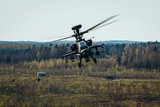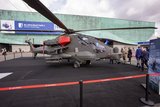RAF Chinooks in Afghanistan
Because of its versatility the current Chinook Force is operating at full stretch, says Gp Capt Turner, with both crewmen and helicopters 'wrung out when they return to the UK'.
More aircraft are arriving, more crew are being trained, and more engineers are being recruited over the coming 12 months:
"This will allow us to raise our game," he said.
So, why isn't every single Chinook being sent to Afghanistan right now?
"There are three distinct groups of helicopters - those in Afghanistan, those used for training at RAF Odiham and elsewhere, and those undergoing in-depth maintenance," said Gp Capt Turner.
The average Chinook goes through a five-season cycle, spending between eight and 13 months (800 flying hours) in Afghanistan - and that's gruelling:
"When they come back we get around 400kg of sand out of the aircraft," said Gp Capt Turner. "It is a spectacular feat of engineering on the ground to keep these aircraft in the air."
So it's not surprising that, after being 'run ragged' for a year, Chinooks need a significant amount of work to make them ready for further service - hence the so-called deep maintenance period.
Following this they head back to RAF Odiham where they are used for basic training - teaching new pilots how to fly and new engineers how to maintain the Chinook. Then there is training with land forces, such as 16 Air Assault Brigade, before they are redeployed to Afghanistan.
There isn't an operation in Afghanistan that doesn't involve Chinooks, whether it is transporting troops to battlefields, taking supplies to remote forward operating bases or evacuating casualties:
"Chinooks are absolutely at the heart of this vital campaign," said the Minister for Defence Equipment and Support, Quentin Davies, on a recent visit to RAF Odiham, the UK base of the heavyweight helicopters and their crews.
"And, because they are at the heart, they are taking risks with their lives every moment they are flying."
The two helicopters lost in separate incidents in August brought home this fact.
Why training for Afghanistan in Chinooks is so important
Pilot, Flight Lieutenant Eleanor Lodge, said: "The first time I saw the dust it was a shock - everybody talks about those few moments where you can't see; as a pilot I don't think you're ever really prepared for it until it actually happens. It's a bit of an eye-opener when you can't see when you're trying to land."
Crewman, Sergeant Greg Wainer, said: "As a crewman, or loadmaster, I recce an area before landing and decide where to put the four wheels of the aircraft. You need to get to that point without making yourself a target, while dealing with the brown-out [sitting in a dust cloud] of a dust landing."
Mechanical engineer, Corporal Tim Bruinsma, said: "In Afghanistan I'm 25 per cent soldier, 75 per cent engineer, so we train in force protection and soldiering. The engineering doesn't change - there's only a certain number of hours Chinooks can run for before they need re-greasing and oil adding. Airframes are checked before all flights, and if a rotor blade takes a bullet then we have to replace it."
By Sharon Kean - Ministry of Defence
More from Defence Helicopter
-
![Germany to send WS-61 Westland Sea King helicopters to Ukraine]()
Germany to send WS-61 Westland Sea King helicopters to Ukraine
Germany has committed to sending Ukraine six of its 21 retiring WS-61 Westland Sea King multirole, amphibious helicopters.
-
![Boeing secures $271 million to advance modernisation of US Special Operations' MH-47G Chinook]()
Boeing secures $271 million to advance modernisation of US Special Operations' MH-47G Chinook
Boeing has clinched a major contract modification to further its backing of the US Special Operations Command’s MH-47G Chinook aircraft modernisation effort.
-
![Dubai Airshow 2023: South Korean homegrown helicopters make international debut]()
Dubai Airshow 2023: South Korean homegrown helicopters make international debut
Two KAI helicopters, the KUH-1E utility helicopter and the Light Attack Helicopter (LAH), have taken centre stage at the Dubai Airshow 2023.
-
![Italian Navy receives final NH90 helicopter]()
Italian Navy receives final NH90 helicopter
The Italian Navy now boasts a fleet of 56 NH90 helicopters comprising 46 SH-90As and 10 MH-90As.
-
![Argentina seeks AW109 and CH-46 Sea Knight helicopters]()
Argentina seeks AW109 and CH-46 Sea Knight helicopters
The Argentinian Air Force (FAA) and the Argentinian Naval Aviation Command (COAN) are looking for options to upgrade their helicopter fleets.
-
![DSEI 2023: Lockheed to produce about 40% of Black Hawks on UK soil if it wins NMH contest]()
DSEI 2023: Lockheed to produce about 40% of Black Hawks on UK soil if it wins NMH contest
Lockheed Martin promises a boost to the British job market and export opportunities, while strengthening ties with Poland and positioning the UK for a future in rotorcraft technology in the event of a New Medium Helicopter competition triumph.

























